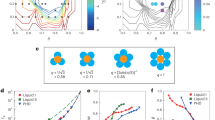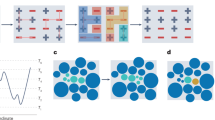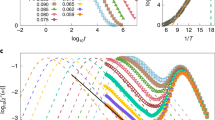Abstract
The transition of a fluid to a rigid glass on cooling is a common route of transformation from liquid to solid that embodies the most poorly understood features of both phases1,2,3. From the liquid perspective, the puzzle is to understand stress relaxation in the disordered state. From the perspective of solids, the challenge is to extend our description of structure and its mechanical consequences to materials without long-range order. Using computer simulations, we show that the localized low-frequency normal modes of a configuration in a supercooled liquid are causally correlated to the irreversible structural reorganization of the particles within this configuration. We also demonstrate that the spatial distribution of these soft local modes can persist in spite of significant particle reorganization. The consequence of these two results is that it is now feasible to construct a theory of relaxation length scales in glass-forming liquids without recourse to dynamics and to explicitly relate molecular properties to their collective relaxation.
This is a preview of subscription content, access via your institution
Access options
Subscribe to this journal
Receive 12 print issues and online access
$259.00 per year
only $21.58 per issue
Buy this article
- Purchase on SpringerLink
- Instant access to full article PDF
Prices may be subject to local taxes which are calculated during checkout




Similar content being viewed by others
References
Debenedetti, P. G. & Stillinger, F. H. Supercooled liquids and the glass transition. Nature 410, 259–267 (2001).
Angell, C. A. Formation of liquids from glasses and biopolymers. Science 267, 1924–1935 (1995).
Swallen, S. F. et al. Organic glasses with exceptional thermodynamic and kinetic stability. Science 315, 353–356 (2007).
Sastry, S., Debenedetti, P.G. & Stillinger, F. H. Signatures of distinct dynamical regimes in the energy landscape of a glass-forming liquid. Nature 393, 554–557 (1998).
Weeks, E. R., Crocker, J. C., Levitt, A. C., Schofield, A. & Weitz, D. A. Three-dimensional direct imaging of structural relaxation near the colloidal glass transition. Science 287, 627–631 (2000).
Berthier, L. et al. Direct experimental evidence of a growing length scale accompanying the glass transition. Science 310, 1797–1800 (2005).
Ediger, M. D. Spatially heterogeneous dynamics in supercooled liquids. Ann. Rev. Phys. Chem. 51, 99–128 (2000).
Kob, W., Donati, C., Plimpton, S. J., Poole, P. H. & Glotzer, S. C. Dynamical heterogeneities in a supercooled Lennard-Jones liquid. Phys. Rev. Lett. 79, 2827–2830 (1997).
Hurley, M. M. & Harrowell, P. Non-Gaussian behavior and the dynamical complexity of particle motion in a dense two-dimensional liquid. J. Chem. Phys. 105, 10521–10526 (1996).
Widmer-Cooper, A. & Harrowell, P. Predicting the long-time dynamic heterogeneity in a supercooled liquid on the basis of short-time heterogeneities. Phys. Rev. Lett. 96, 185701 (2006).
Widmer-Cooper, A. & Harrowell, P. Free volume cannot explain the spatial heterogeneity of Debye–Waller factors in a glass-forming binary alloy. J. Non-Cryst. Solids 352, 5098–5102 (2006).
Widmer-Cooper, A., Harrowell, P. & Fynewever, H. How reproducible are dynamic heterogeneities in a supercooled liquid? Phys. Rev. Lett. 93, 135701 (2004).
Rabani, E., Gezelter, J. D. & Berne, B. J. Calculating the hopping rate for self-diffusion on rough potential energy surfaces: Cage correlations. J. Chem. Phys. 107, 6867–6876 (1997).
Volmayer-Lee, K. Single particle jumps in a binary Lennard-Jones system below the glass transition. J. Chem. Phys. 121, 4781–4794 (2004).
Perera, D. & Harrowell, P. Relaxation dynamics and their spatial distribution in a two-dimensional glass-forming mixture. J. Chem. Phys. 111, 5441–5454 (1999).
Mazzacurati, V., Ruocco, G. & Sampoli, M. Low-frequency atomic motion in a model glass. Europhys. Lett. 34, 681–686 (1996).
Schober, H. R. & Ruocco, G. Size effects and quasilocalized vibrations. Phil. Mag. 84, 1361–1372 (2004).
Schober, H. R. & Laird, B. B. Localized low-frequency vibrational modes in glasses. Phys. Rev. B 44, 6746–6754 (1991).
Brito, C. & Wyart, M. Heterogeneous dynamics, marginal stability and soft modes in hard sphere glasses. J. Stat. Mech. 76, L08003 (2007).
Coslovich, C. & Pastore, G. Are there localized saddles behind the heterogeneous dynamics of supercooled liquids? Europhys. Lett. 75, 784–790 (2006).
Berthier, L. et al. Spontaneous and induced dynamic fluctuations in glass formers. I. General results and dependence on ensemble and dynamics. J. Chem. Phys. 126, 184503 (2007).
Lechenault, F., Dauchot, O., Biroli, G. & Bouchaud, J.-P. Critical scaling and heterogeneous superdiffusion across the jamming/rigidity transition of a granular glass. Preprint at <http://arxiv.org/abs/0706.1531> (2007).
Zeravcic, Z., van Saarloos, W. & Nelson, D. R. Localization behavior of vibrational modes in granular packings. Preprint at <http://arxiv.org/abs/0802.3440> (2008).
Doliwa, B. & Heuer, A. What does the potential energy landscape tell us about the dynamics of supercooled liquids and glasses? Phys. Rev. Lett. 91, 235501 (2003).
Sturgeon, J. B. & Laird, B. B. Symplectic algorithm for constant-pressure molecular dynamics using a Nosé–Poincaré thermostat. J. Chem. Phys. 112, 3474–3482 (2000).
Acknowledgements
We would like to thank L. Berthier, G. Biroli, J. P. Bouchaud, A. Heuer, and C. O’Hern for discussions. H.P. and D.R.R. would like to thank P. Verrocchio for providing the equilibrated three-dimensional configurations and NSF for financial support. A.W.-C. and P.H. acknowledge the support of the Australian Research Council. H.P. was partially supported by the MRSEC program of the National Science Foundation under grant No DMR-0213574.
Author information
Authors and Affiliations
Contributions
P.H. and D.R.R. conceived this study and wrote the paper. A.W.-C. carried out the MD simulation, analysed the motions and devised the contour plots. H.P. carried out the normal-mode analysis and graphical representation of the eigenfunctions.
Corresponding authors
Supplementary information
Supplementary Information
Supplementary Information and Supplementary Figures 1–9 (PDF 1544 kb)
Rights and permissions
About this article
Cite this article
Widmer-Cooper, A., Perry, H., Harrowell, P. et al. Irreversible reorganization in a supercooled liquid originates from localized soft modes. Nature Phys 4, 711–715 (2008). https://doi.org/10.1038/nphys1025
Received:
Accepted:
Published:
Issue date:
DOI: https://doi.org/10.1038/nphys1025
This article is cited by
-
Low-frequency vibrational density of states of ordinary and ultra-stable glasses
Nature Communications (2024)
-
Modern computational studies of the glass transition
Nature Reviews Physics (2023)
-
Topology of vibrational modes predicts plastic events in glasses
Nature Communications (2023)
-
Developing novel amorphous alloys from the perspectives of entropy and shear bands
Science China Materials (2023)
-
Machine learning atomic dynamics to unfold the origin of plasticity in metallic glasses: From thermo- to acousto-plastic flow
Science China Materials (2022)



